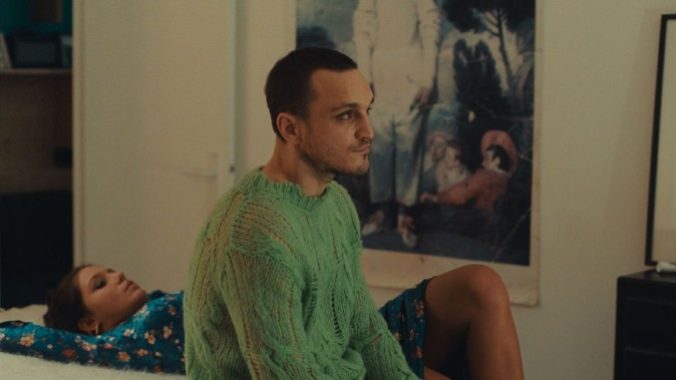Passages’ NC-17 Rating Reflects the MPAA’s Queerphobic History

One of the least surprising things about mainstream Hollywood is its horror and disdain towards queer people. We’ve made incredible leaps forward in terms of how LGBTQ+ stories are portrayed for wide audiences, with layered representations of queerness of all kinds more plentiful than ever. That doesn’t mean the industry has wholly embraced the community or isn’t prone to startling displays of bigotry. Amid the Pride Month Twitter posts and shoddy merchandise, it’s evident that there’s still a long way to go before we achieve true liberation. Look no further than the recent decision by the Motion Picture Association (MPA) to slap the acclaimed romantic drama Passages with an NC-17 rating.
Passages, directed by Ira Sachs, tells the story of an affair between a tempestuous filmmaker (played by Franz Rogowski) and a teacher (Adèle Exarchopoulos), despite the former being married to a male artist (Ben Whishaw). Sachs and the film’s distributor MUBI condemned the MPA’s decision. In a statement, MUBI said that the “NC-17 rating suggests the film’s depiction of sex is explicit or gratuitous, which it is not, and that mainstream audiences will be offended by this portrayal, which we believe is also false.” MUBI will release the film unrated.
Sachs directly called out the MPA’s homophobia, saying, “We’re talking about a select group of people who have a certain bent, which seems anti-gay, anti-progress, anti-sex—a lot of things which I’m not.” It’s a reminder of how deeply sex of any kind, but especially that which doesn’t fit into the stifling mold of cishet people fumbling under the covers, remains curiously stigmatized by the mainstream entertainment industry. In many ways, we’re still stuck several decades in the past, with remnants of the Hays Code embedded in the modern discourse.
The Hays Code was Hollywood’s desperate attempt to rehabilitate its increasingly decadent image in the face of powerful protests from the Catholic League and “concerned” parent groups. Religious groups saw film as a tool of evil designed to spread amoral ideas (an idea heavily rooted in the fact that many of the industry’s leaders were Jewish). Portrayals were seen as explicit endorsements, and such things were to be stamped out. The Code infamously limited portrayals of gender, sexuality, race, and law and order. “Good” must win the day over “evil,” even if the latter’s standards included things as benign as women with autonomy, gentle mockery of the clergy, or interracial romance. Queerness was not explicitly condemned, but it didn’t need to be. The Catholic scorn that repeatedly demanded genteel portrayals of the sanctity of marriage between man and woman spoke loudly enough of their views on the subject. They were part of the ban on “sex perversion.”
The American movie world quickly fell into line. Queerphobia is baked into the roots of Hollywood, but it’s important to note the distinction between the restrictive model of the mainstream American corporate interests and the art form of cinema itself. Remember, one of the very first pieces of film we have is of two men cozily dancing with one another. Queerness has been present on the big screen for decades, albeit in covert forms. The Celluloid Closet documented the ways that LGBTQ+ presences are embedded in film history, from Peter Lorre’s shady character in The Maltese Falcon to Katharine Hepburn in boy drag in Sylvia Scarlett to the scorching sexual angst of Ben-Hur. The queer undertones of characters like Mrs. Danvers in Rebecca were always there for people who knew where to look. Stories of explicit queerness found ways around the Code, such as The Children’s Hour, a drama about the fallout of an accusation of a lesbian romance between two teachers at a girls’ school. Happy endings for such stories were out of the question and nobody ever says the word “gay” in that film, but their presence in the cultural landscape mattered greatly.
Of course, queerness was never absent from film, and you only have to look outside of America to see radical and empathetic narratives that place our very existence front and center. Basil Deardon’s Victim bravely named homosexuality and sympathetically portrayed the pain of living under bigoted laws at a time when it was still illegal in Britain (the Code-era production board, predictably, denied it their seal of approval at first, before relenting a year after its initial release). The Japanese art film Funeral Parade of Roses put trans women front and center in 1969, its release happening half a world away from the Stonewall riots. The German romantic drama Mädchen in Uniform was so beloved for its heartfelt portrayal of the troubled passion between a student and her teacher that Eleanor Roosevelt preached its beauty even as the Code banned it from release. And this doesn’t even get into the world of underground American cinema, from John Waters to Kenneth Anger to documentaries like The Queen and Portrait of Jason.
-

-

-

-

-

-

-

-

-

-

-

-

-

-

-

-

-

-

-

-

-

-

-

-

-

-

-

-

-

-

-

-

-

-

-

-

-

-

-

-








































